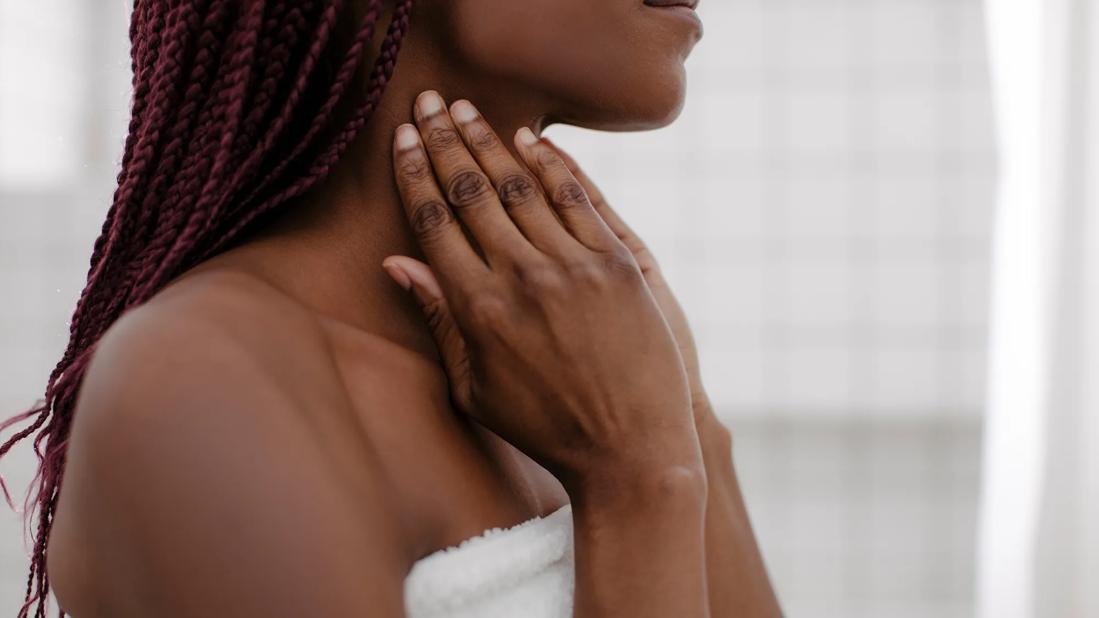This light, gentle technique may decrease swelling, lessen facial puffiness and just help you relax

Seeing a massage therapist for lymphatic drainage massage may help you find relief from fluid buildup and even painful swelling. This gentle massage technique moves lymphatic fluid (aka lymph) throughout your body.
Advertisement
Cleveland Clinic is a non-profit academic medical center. Advertising on our site helps support our mission. We do not endorse non-Cleveland Clinic products or services. Policy
But if you can’t get in to see a professional as often as you’d like, it’s time to take matters into your own hands — literally.
“You can do lymphatic drainage self-massage at home,” says massage therapist Tori Harsha, LMT. “It’s a very easy technique to learn and a very beneficial form of self-care.”
Lymphatic drainage self-massage involves gently manipulating certain areas of your body to help move excess fluid away from your tissue and toward your major lymph nodes. You may benefit from it if you have:
It only takes a few minutes to do a DIY lymphatic drainage facial from the comfort of your own home. Talk about a soothing way to start the day!
“It’s great if you wake up a little puffy or congested, and you just want to get that swelling to go down before you head into work,” Harsha says. “The goal is to pull the fluid from your face toward the lymph nodes in your chest and armpit area.”
A few tips before you begin:
Advertisement
Here’s how to do it:
You have hundreds of lymph nodes throughout your body, but they’re clustered in certain areas of it. Begin by stimulating the axillary lymph nodes in your armpits, which gets them ready to receive additional lymphatic fluid.
Remember to keep it light. “You want to be very strategic about where and how you’re pushing,” Harsha reiterates. “You should just be massaging the skin; you don’t want to access muscle tissue.”
With the palm of your right hand, press lightly on your center chest and out toward your left armpit. Repeat the motion, moving your left hand toward your right armpit. Do this 10 more times, adopting a rhythmic motion.
Put your hands on either side of your neck, with the pads of your fingers resting slightly below your ears — this is just beneath your occipital lobe (the bottom of your skull) and the back of your jaw.
Move your fingers in a gentle, circular motion, moving your skin downward toward your chest. Repeat this motion five to 10 times.
“You want to gently pull down toward the lymph nodes, which pulls down the lymphatic fluid and flushes out the area,” Harsha explains. You may start to feel some drainage in the back of your throat.
You have lymph vessels all over your face, Harsha says, so it’s time to perform the same circular motion on your forehead.
Use your fingers to gently make circles above your eyebrows, moving downward to your temples. Repeat at least 10 times.
Performing MLD here may lessen congestion and decrease puffiness, Harsha says.
With the pads of your fingers on the apple of your cheeks, make the same gentle, downward, circular motion. Repeat 10 times, though you don’t have to stay in exactly the same place with each circle. It’s OK to move up your cheekbones, if that feels good.
“You’ll really start to feel it as you flush out that fluid and increase flood flow to the area,” Harsha notes.
Returning to your chest area, perform the same light, sweeping motion you did in the beginning: right hand to left armpit, left hand to right armpit, for a total of 10 times.
“You always want to go back where you began and flush out those main lymph nodes again,” Harsha further explains. “You’re just trying to get that excess fluid to move into those axillary lymph nodes before you wrap up.”
Plus, Harsha shares two key tips for winding down after you’ve given yourself this type of massage:
Advertisement
You shouldn’t do lymphatic self-massage when you’re in the active phase of an illness.
“If you currently have a sinus infection or any other sort of infection, make sure you’ve been on antibiotics for at least a week before you have any sort of lymphatic drainage work done,” Harsha states.
MLD is also not a fit for people who have:
Finally, lymphatic self-massage is also often recommended for people with lymphedema, a condition that keeps your lymphatic fluid from flowing as it should. But if you have a lymphedema diagnosis, you should always speak with your healthcare provider before trying it.
And, in general, it’s always best to check in with a healthcare provider first. But if they give you the go-ahead, this simple, soothing technique is worth working into your regular self-care routine.
Advertisement
Learn more about our editorial process.
Advertisement

Breathing, exercise, mindfulness and more can help you unwind and step away from your stress

Move a little more, eat a little healthier, sleep a little better and destress a lot

From breath meditation to yoga nidra, all types of meditation aim to help you feel calmer, more relaxed and present

This fruit has clear nutritional benefits — but there’s little evidence it can prevent or treat illness

Until there’s more research on it, this plant’s greatest claim to fame is its deliciousness

Hot tub sessions can help relieve stress, soothe sore muscles and improve heart health

Stand tall and feel grounded with this foundational yoga pose

Different types of yoga poses, meditation and breathwork may help you feel more emotionally balanced

Babies can get congested easily, but you can calm their cough by keeping them hydrated, using nasal drops and running a humidifier

Weight loss may cause loose, sagging skin and muscle loss to your rear

Several conditions, like vitiligo and fungal infection, can cause a loss of pigmentation, leading to white spots or patches on your skin